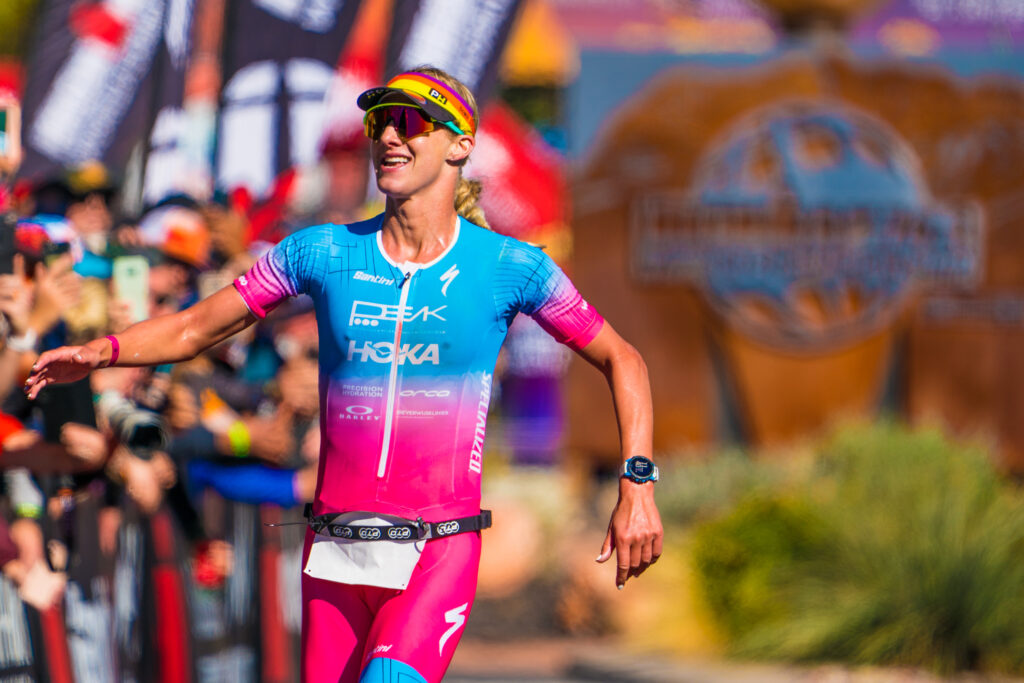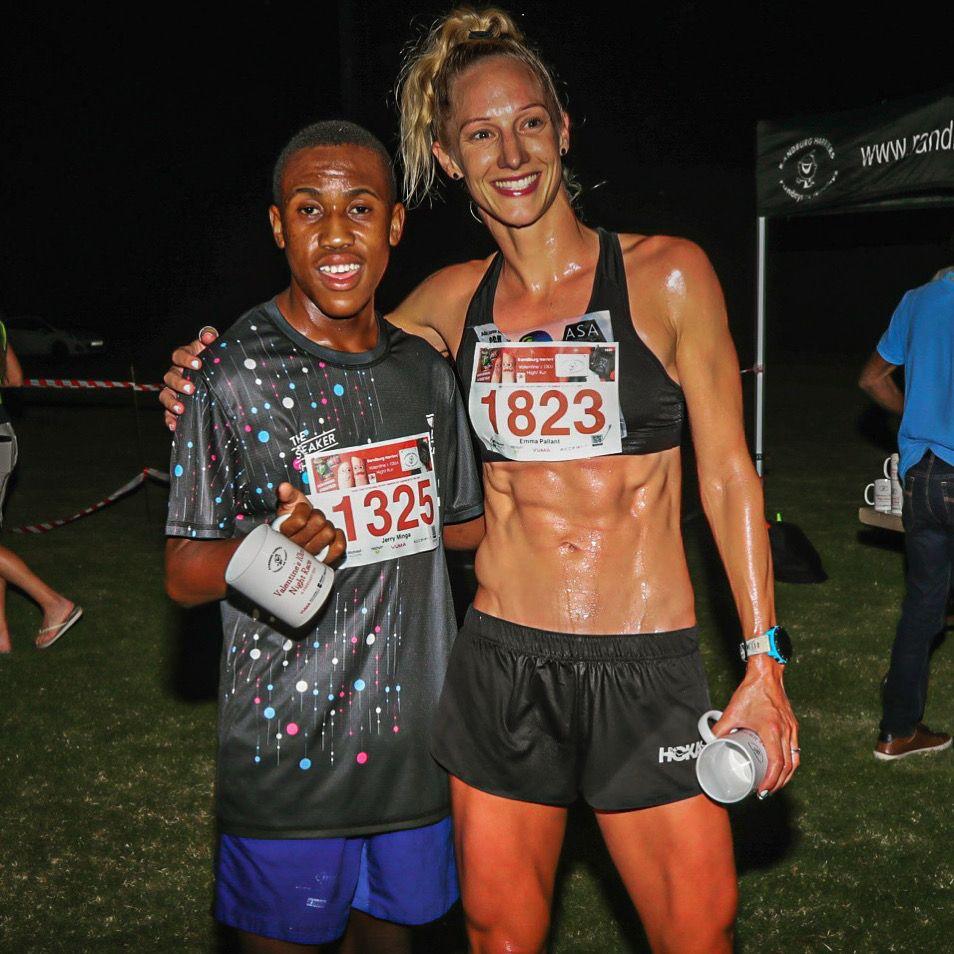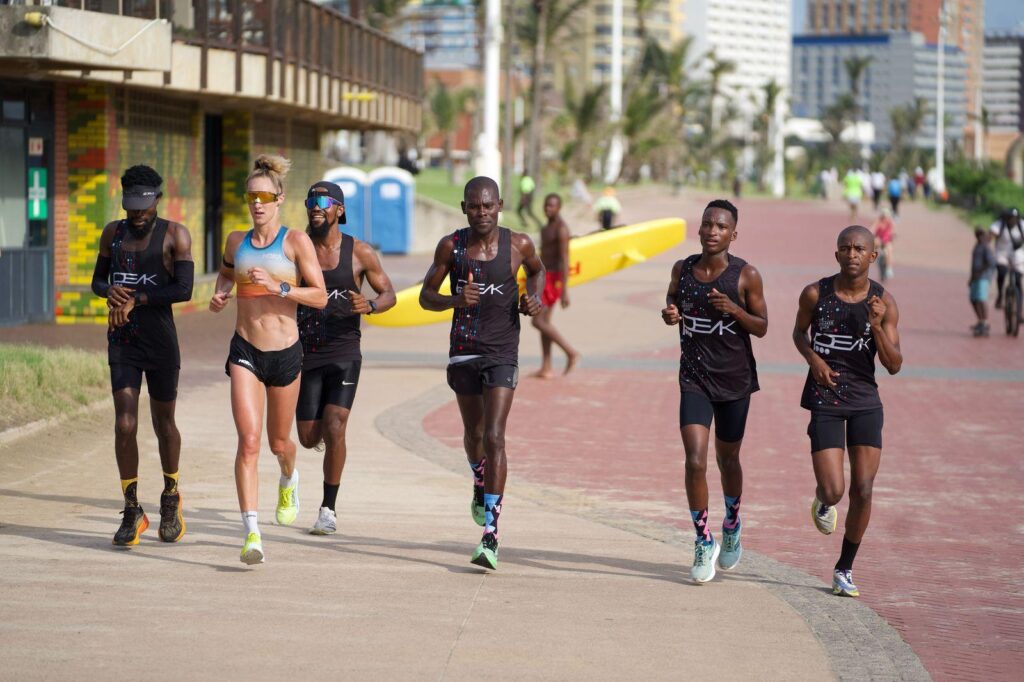Emma Pallant-Browne, The Queen of 70.3 Racing, Wants More

Story By Sarah Kim Bonner
In her signature high blonde ponytail, Emma Pallant-Browne is telling me something I never expected. At her home in Johannesburg, the Brit has let the South African vernacular influence her accent. Punctuated with a “ja” every few sentences (the Afrikaans word for “yes” used like “yeah”), she explains her race plans for the upcoming season and beyond. Tied with Daniela Ryf as the most-winning female at the 70.3 distance, she is poised to surpass that record but that’s not the part of Pallant-Browne’s plans that has my jaw on the floor.
Most Winning Woman
“A stats guy wrote and showed I was level on 70.3 wins with Daniela Ryf, so this year Jaryd [her husband] was like you have to win another.”
Pallant-Browne has racked up twenty-two 70.3 wins (plus another six non-IRONMAN branded half-distance titles), which includes a second place finish behind Ryf at the 2017 Ironman 70.3 World Championships and a third place in 2022 behind Taylor Knibb and Paula Findlay. Arguably, there is more competition these days, but with only one more 70.3 win needed to write her name in the history books, it only seems like a matter of time.
“To win the most 70.3s, to me, would be really special because triathlon is a really hard sport, so much can go wrong and combine that with the travel, even things like getting sick on the plane, your bike arriving in one piece, etc., it would be testimony to the amazing people I have on my team,” she said. “The sponsors, friends and family, the amount of time I’m away and special moments in their lives I’ve had to say no to, it takes a lot of sacrifice and nice to have something to show for it.”

Torn
At this stage in her career, Pallant-Browne seems to have the winning formula, but the T100 threw her a curveball. The former pro runner hasn’t managed the same success at the slightly shorter distance. With deeper competition and less margin for deficit, her best result was a fifth in San Francisco, followed by two 10th place finishes in Ibiza and London. She’s also had two DNFs last year.
“Last year I struggled,” she said. “ I don’t think T100–I know that it’s definitely not where my strength is.”
She doesn’t mention it until asked, but throughout the season she was also dealing with a serious health issue. A scope revealed a bleeding tear in her gut that eventually forced her to take a month off to undergo a two week treatment.
“As triathletes, you’re used to feeling tired and you push through,” she said. “It’s a tough sport and you just get on with it. I think sometimes it’s only when you break and you heal your body, you come out the other end and realize. I was feeling terrible. I was getting through each day, rather than living and training to push my body. I was just surviving.”
In a mix of redemption and curiosity, Pallant-Browne accepted another T100 contract for 2025–a coveted offer only given to the top-10 men and women.
“ It was a tough decision,” she says, adding it involved conversations with both her husband, Jaryd, and her coach, Tim Don.
“Somehow, in a bad year, I still managed to hold on to a contract,” she said. “We had so many conversations about it and it wasn’t an easy decision. But, when we found out you only have to do six of the ten races, I was like, okay, I can still do a reasonable number of 70. 3s.”

Overcome
It’s not the first time Pallant-Browne has struggled with a distance. As she transitioned from running into triathlon, the natural goal was Kona. After two very successful years racing half distances, she stepped up in 2018 with her debut at Ironman South Africa. A pulled calf on the bike stopped her from finishing, but that only motivated her to line up six months later in Austria. Pallant-Browne finished third, earning herself a start in Kona, but missed her podium celebration because she was in the medical tent suffering from the effects of the heat.
In Kona, she had trouble from the heat again, collapsing in T2. Her last, and final, attempt at the distance was in 2019 at Ironman Lanzarote. Recognizing the symptoms of heat stress, she stopped on the bike just before fainting. Later, on social media, she announced she wouldn’t be pursuing full distance racing.
“With sadness I will respect the advise of the medics post Kona and my cardiologist and will be focusing on being the best I can be at the 70.3,” she wrote. “But hell I’m glad we threw everything at it.”
Throwing Everything at It
“Throwing everything at it,” is a running theme for Pallant-Browne. In the past, it hasn’t always been a positive thing. She came through RED-S as a young athlete, thinking full commitment meant losing her natural cycle. In Kona, even after fainting in T2, she tried to go out and finish the run. It seems fitting that her lack of mastery over the T100 would stir up her innate drive to do everything to conquer the distance.
Thankfully, at this stage in her career, the 35 year old is wiser, more experienced, and “everything” looks a little different.
“ I’ve got to the point in my career where, thankfully, I’m making the prize money to be able to fund my career,” she said. “It’s getting closer and closer in the races and it has to, at some point, be all about performance.”
It’s meant saying no to sponsors and turning down financial and product partnerships many would envy. It’s meant prioritizing health, even if that involved taking a month off and missing the 70.3 World Championships in Taupō to heal her gut. It’s meant taking a T100 contract, but keeping her strong presence on the 70.3 circuit.
It’s meant being more Emma.
“ I was taking on a lot of sponsorships and then finding that it’s really hard–I want to be authentic,” she said.“ We’ve cut back a little on sponsorship and I’ve focused on more on the products that I need and the sponsorships that I really think I can be of value, but also value to other people. What product is going to get you faster, what product is going to be the best for races, so you can keep getting those results.”

More Emma
The fact is, Pallant-Browne has changed since she launched her triathlon career over a decade ago. In between the wins and near wins and the DNFs, she’s cultivated a career that not only consistently ranks her as one of the best in the world but one that is truly a reflection of who she has become.
Apart from her results, she has built a community through ten years of coaching and the triathlon club she and her husband organize.
She has stood up for women in sport, proudly defending a racing photo that went viral because it showed leaked menstrual blood, ensuring women have their own space in their club, and speaking to young women and girls to get them into sport and help them stay healthy.
She has also followed through on her dream to start a running project to create opportunities for the underprivileged.
“When I was a runner and we went to Kenya, I just saw the great work that they did there and how running actually changed lives,” she said. “How many of the guys had become professional runners from running at school to then being elevated to American scholarships and things–it was something I always thought was amazing and I always wanted to be a part of somewhere.”
“Moving [to South Africa] I could see the need in some of the communities… and surely that there were some talented runners,” she continued.

After setting up a race and a weekly training session in one of the local townships, Pallant-Browne and her husband started supporting a few of the runners.
“We started supporting the ones that were turning up all the time,” she said. “We give them shoes, clothes and when it was their holidays and they wouldn’t get food at school, we’d come with food. You can see the ones that are passionate. There was one guy in particular that was super passionate. So we gave him a watch and started helping him clock his training sessions, giving him advice and then he started leading the young ones. He’s winning races, winning prize money and he’s started to be a really good role model. And that’s how we want it to be–organic, and come from them.”
Surprises
Pallant-Browne isn’t the only one who has changed and grown. The landscape of triathlon has developed over her career with higher levels of performance, more competition, and different opportunities–and that’s when she drops the news anyone who knows her history wouldn’t see coming.
“ If I didn’t take a T100 contract, I was gonna do a full,” she said.
For any other top-level half distance pro, stepping up to long course always seems like an inevitable career progression, but with her medical issues and public declaration, it’s a true surprise.
“Kona always put me off,” she says, referencing the extreme heat conditions. “But then I watched Nice and I was like–yoh, that’s it.”
What made the choice to take an otherwise dream offer of a T100 contract difficult was a fire reignited by the women’s IRONMAN World Championships in Nice. With excited wide eyes and a massive smile, she admits she almost started her 2025 season with IRONMAN South Africa in March. But just back to full training in December after her gut repair, her team talked her down from madness and we’re going to have to wait for her full distance debut 2.0 until next season.
“I was nervous to commit a full season to just long course racing, but the more I’m in the sport, the more it’s appealing to me,” she said. “I love the hours of training and stepping up. It just now seems like a natural progression.”
And then she drops a second piece of surprising and exciting news: she’s pregnant.
“Yup, things have definitely now changed,” she says excitedly.
“Little babski is due in September, so I’ll hopefully go into birth with some fitness and then set my 2026 goals,” she said.
Pallant-Browne has a few more plays to make and, whether it’s motherhood, advocacy, or racing, she is truly ready and hungry for more.




thanks for this article - good read.
I didn’t realize Emma is in Johannesburg and running training camps for the locals, good for her !